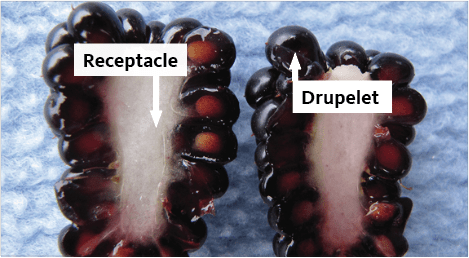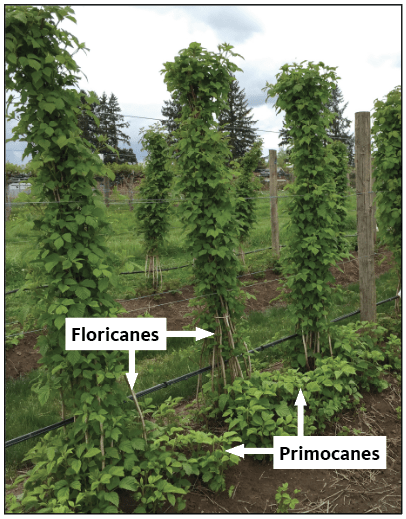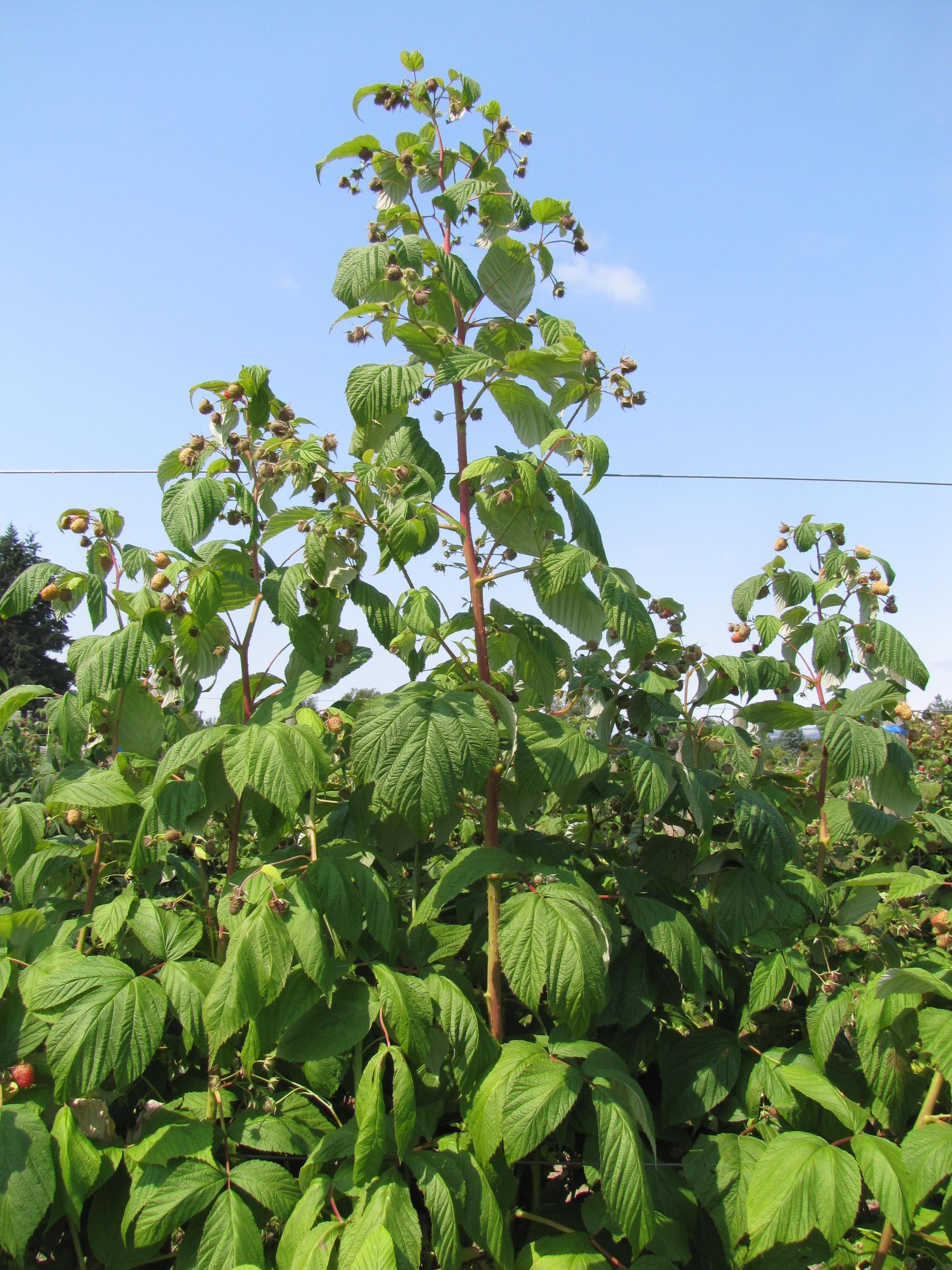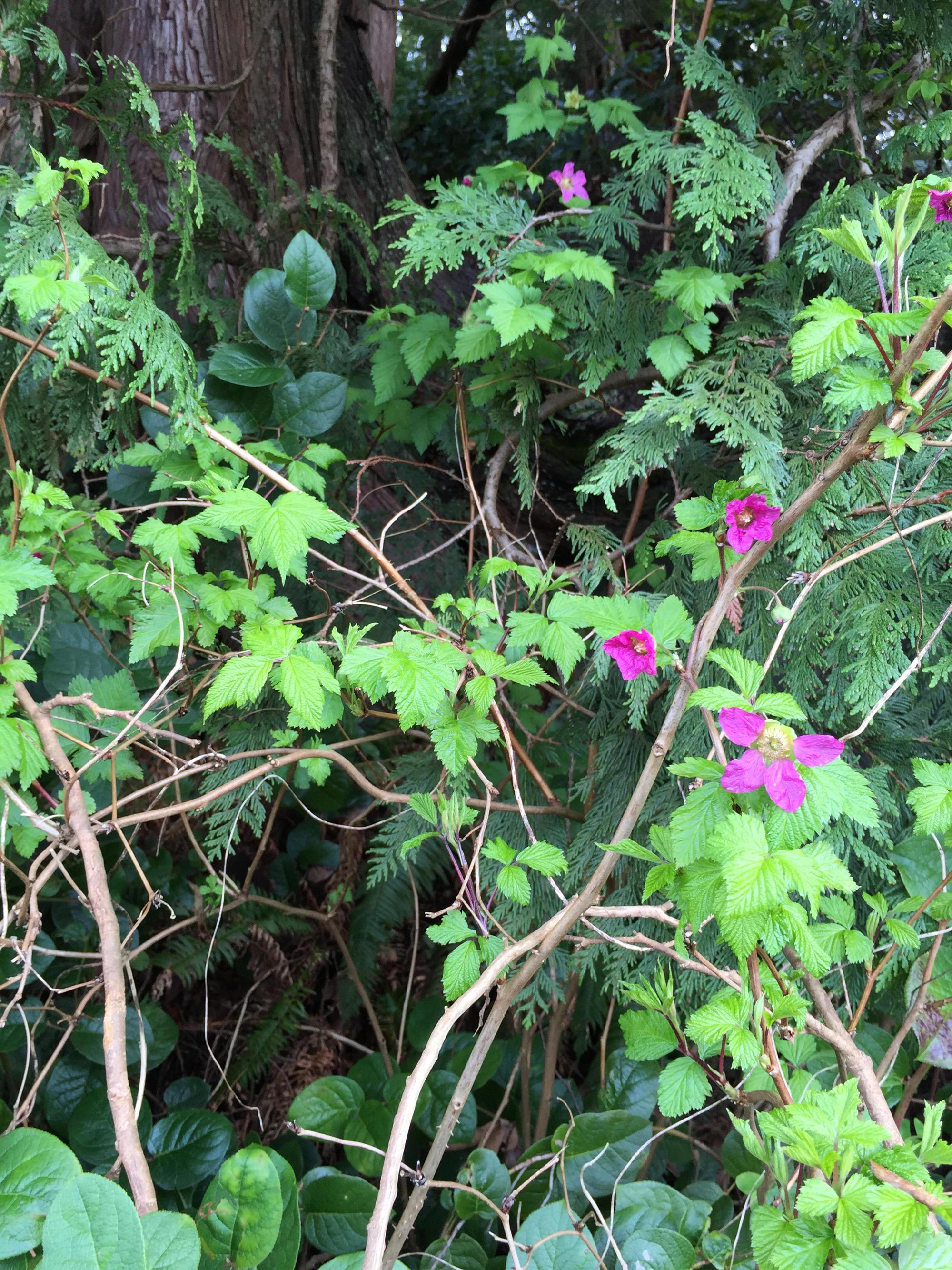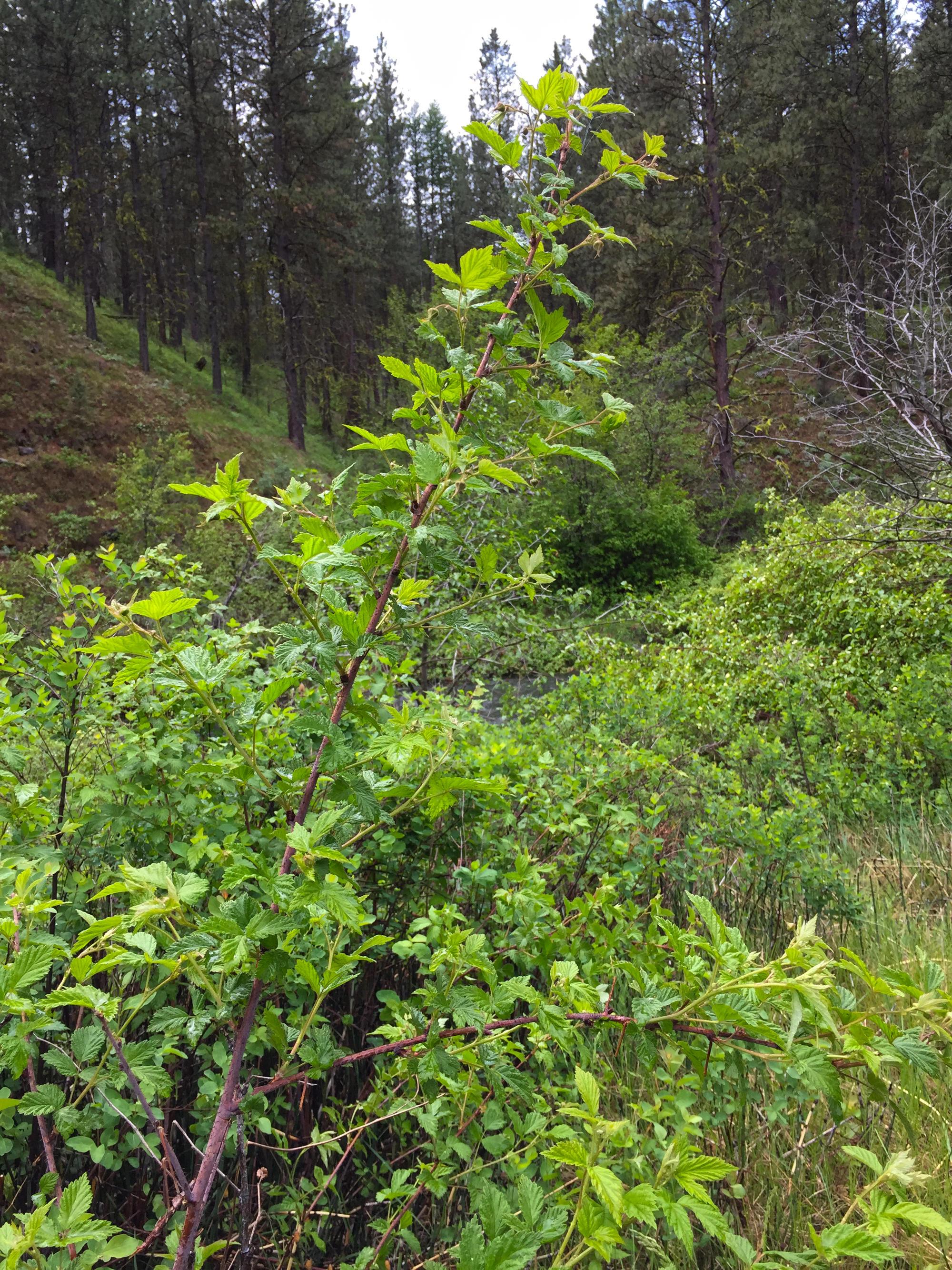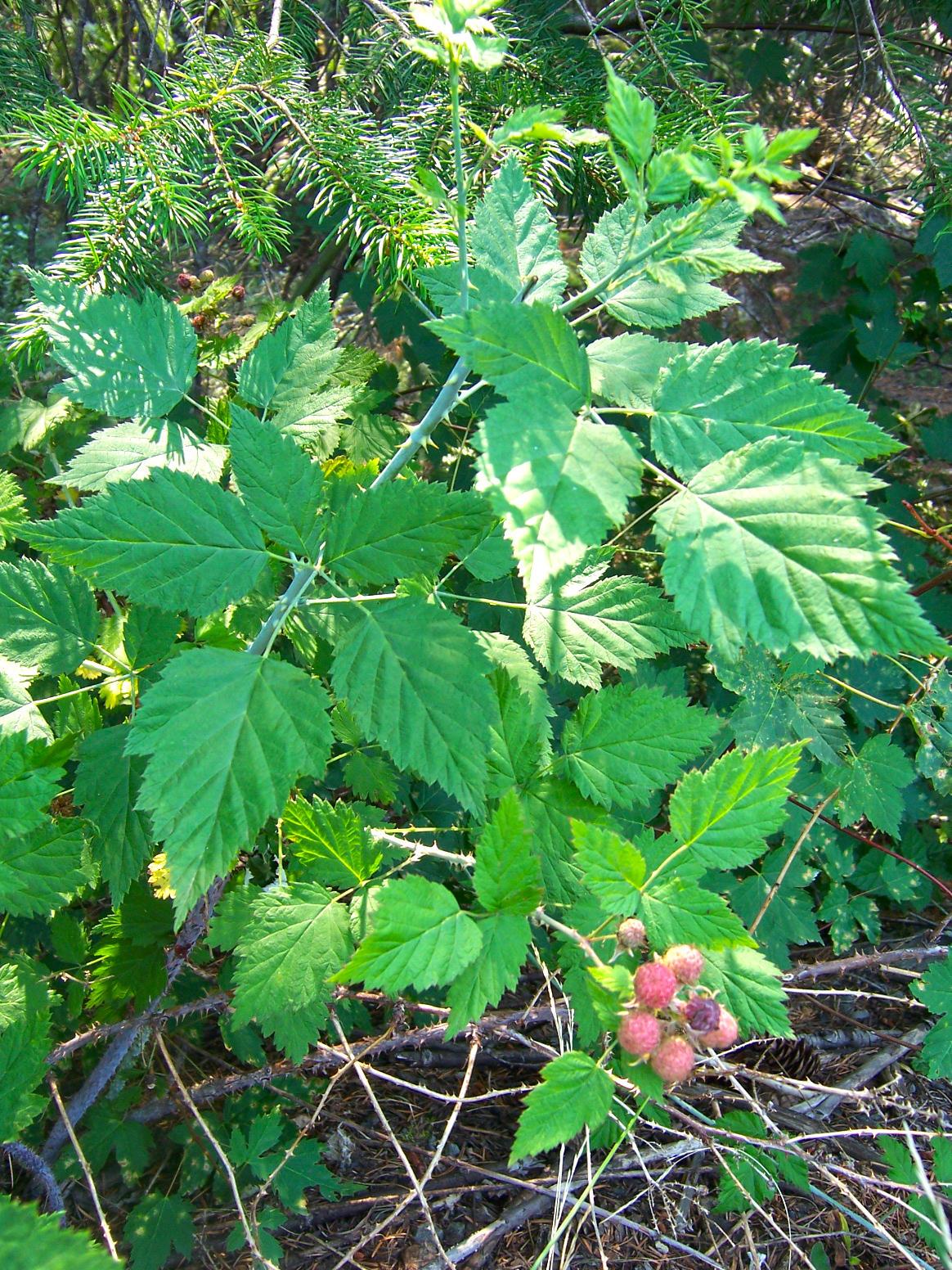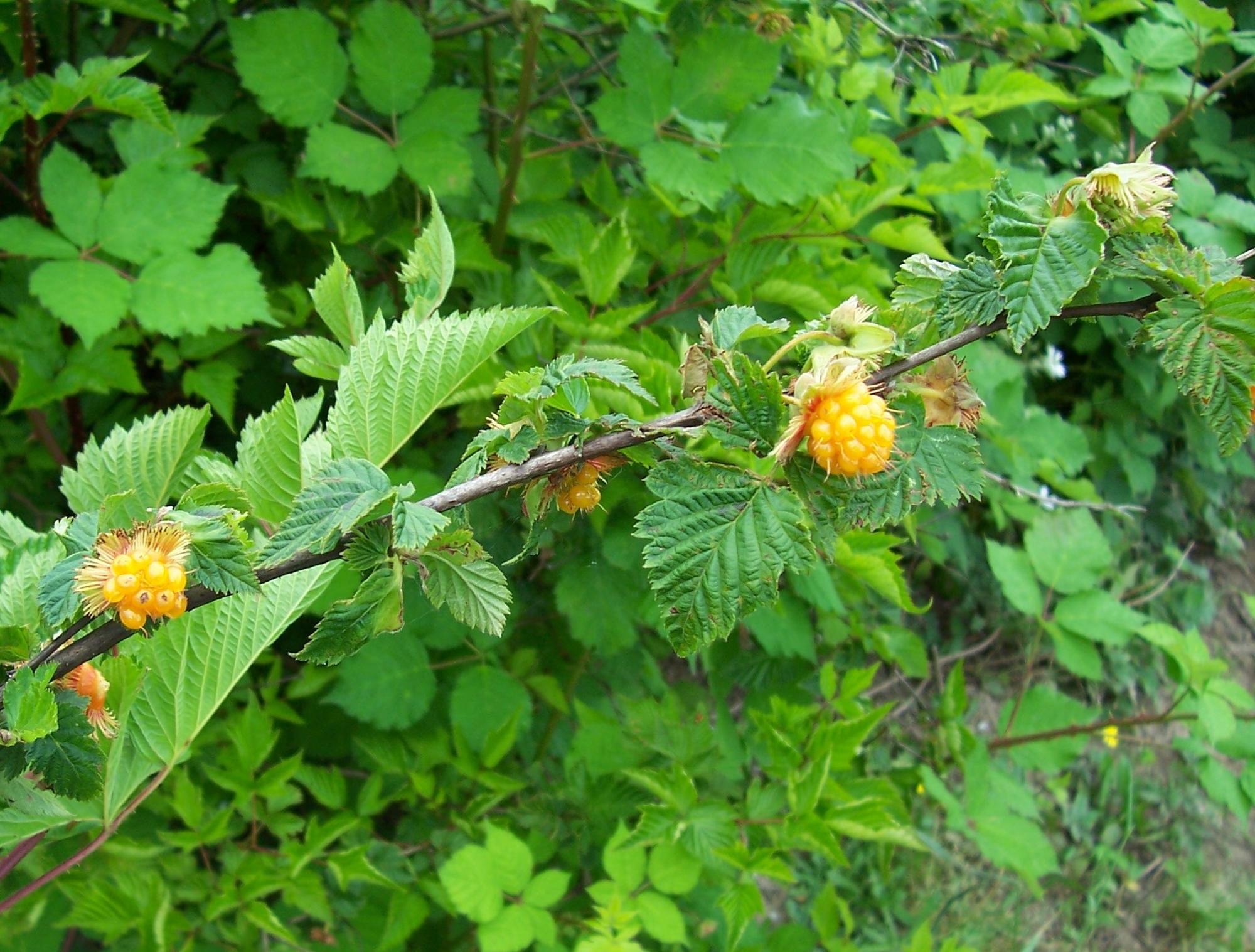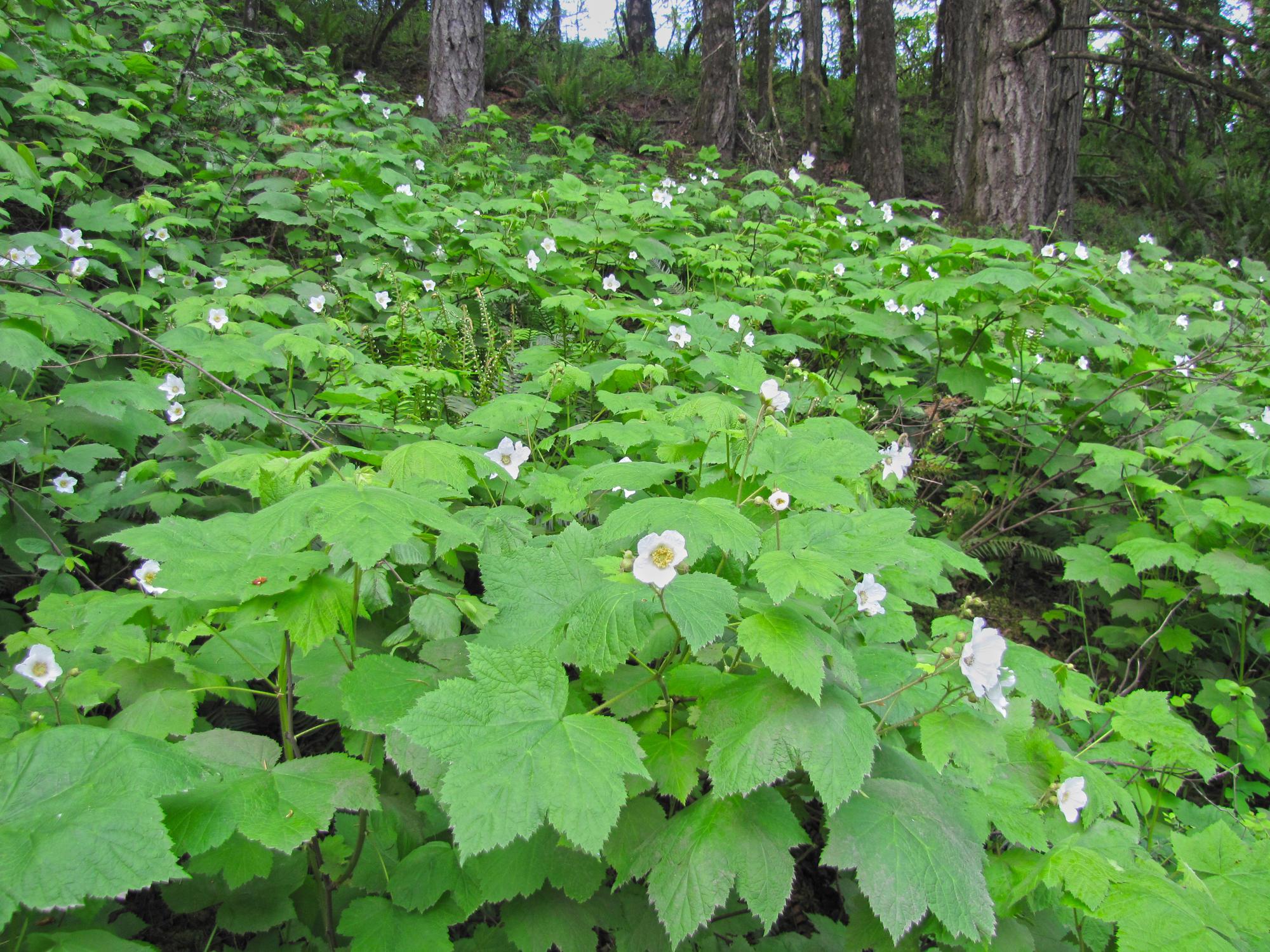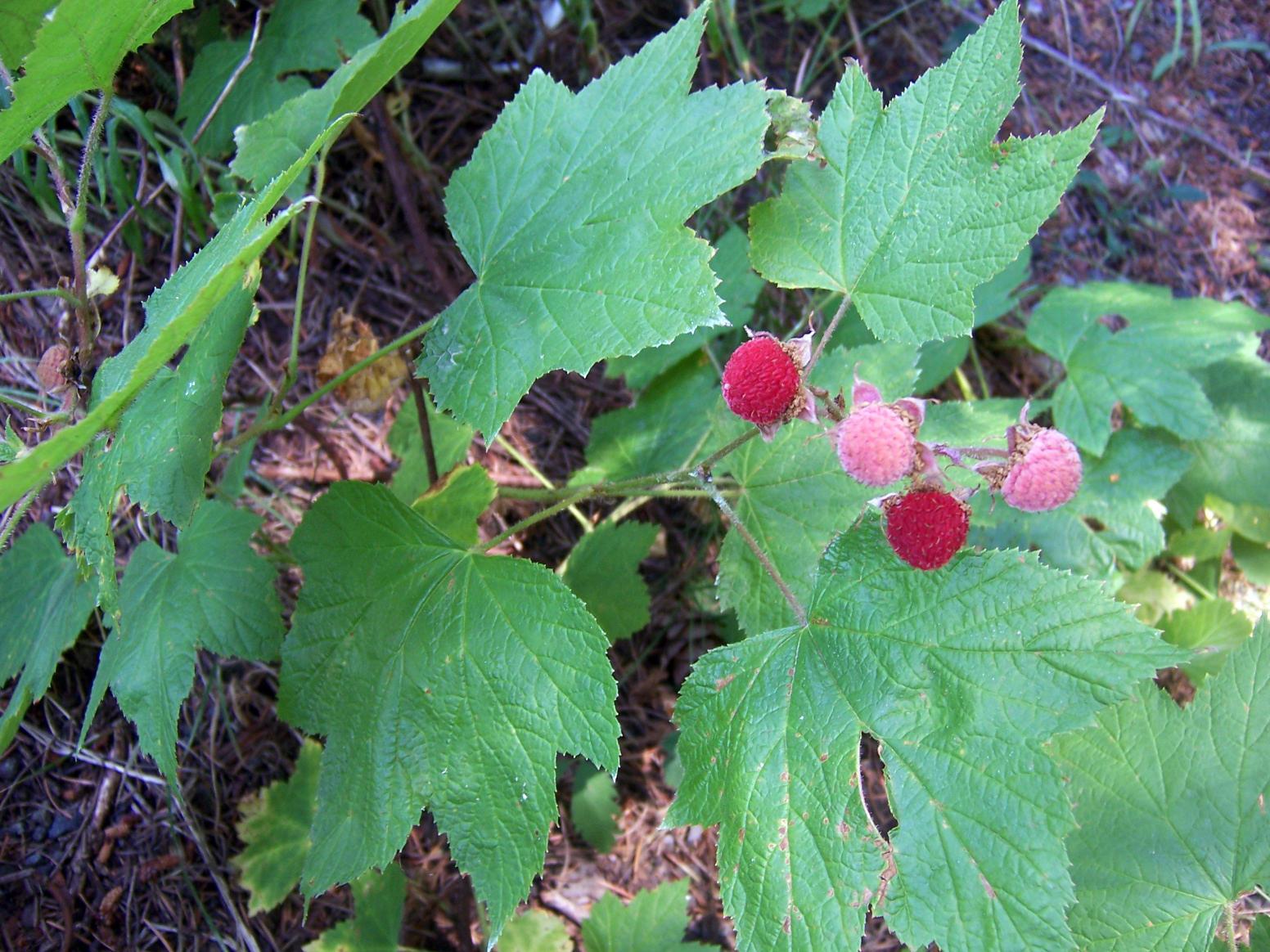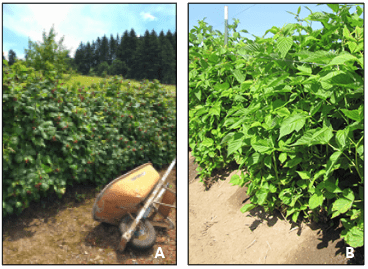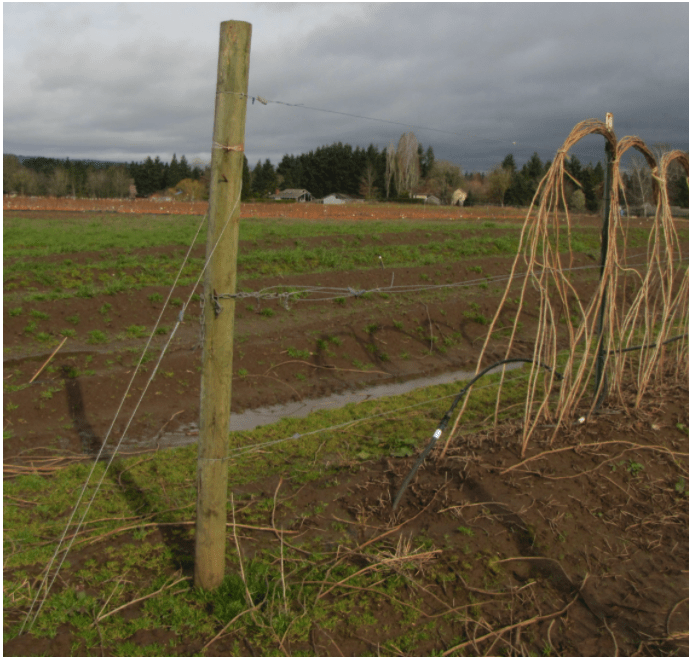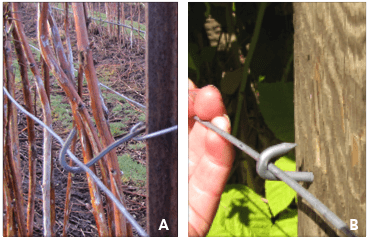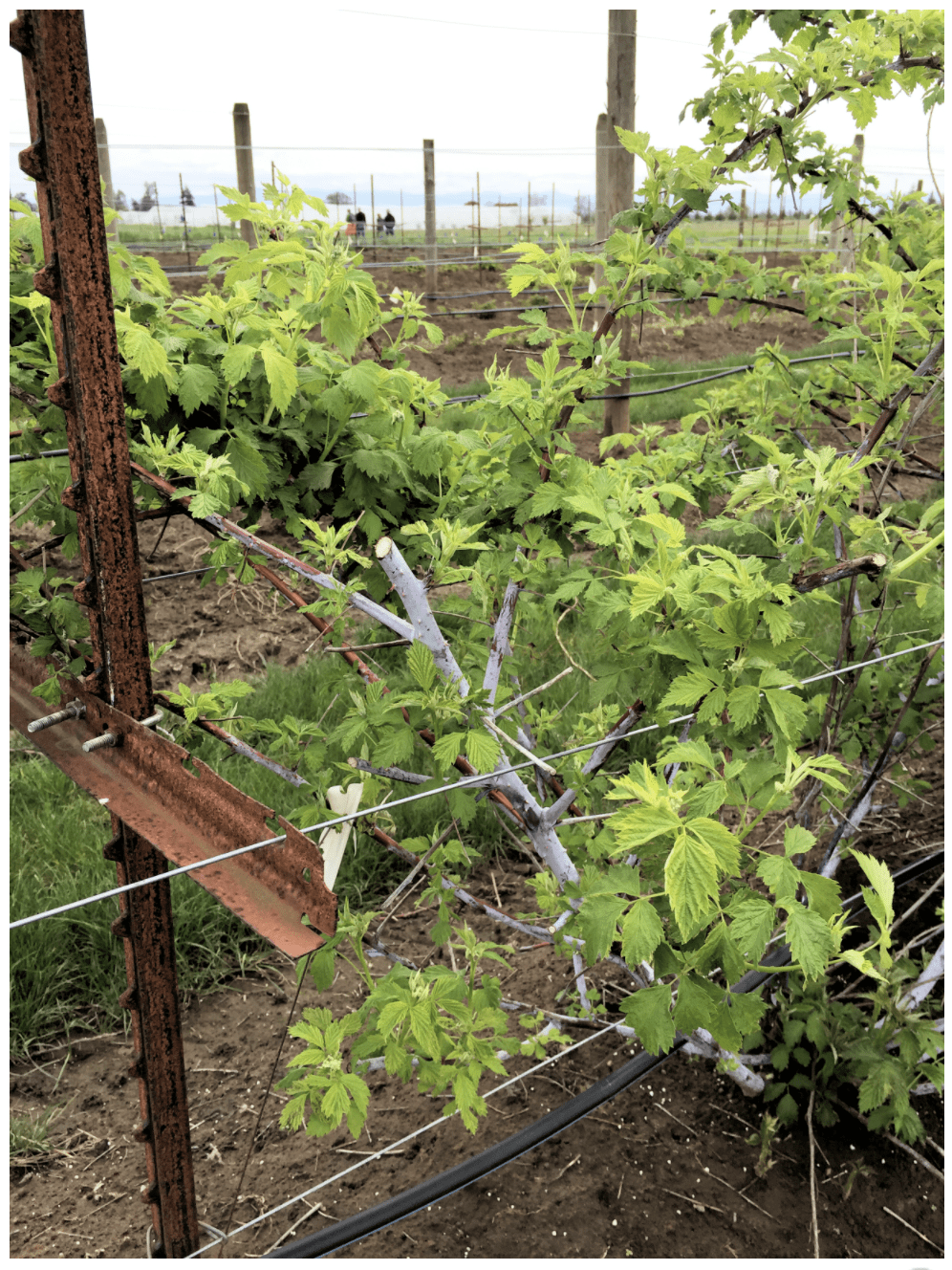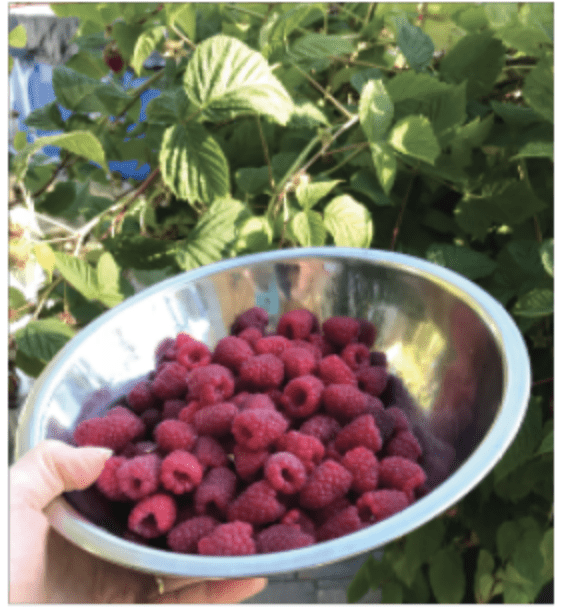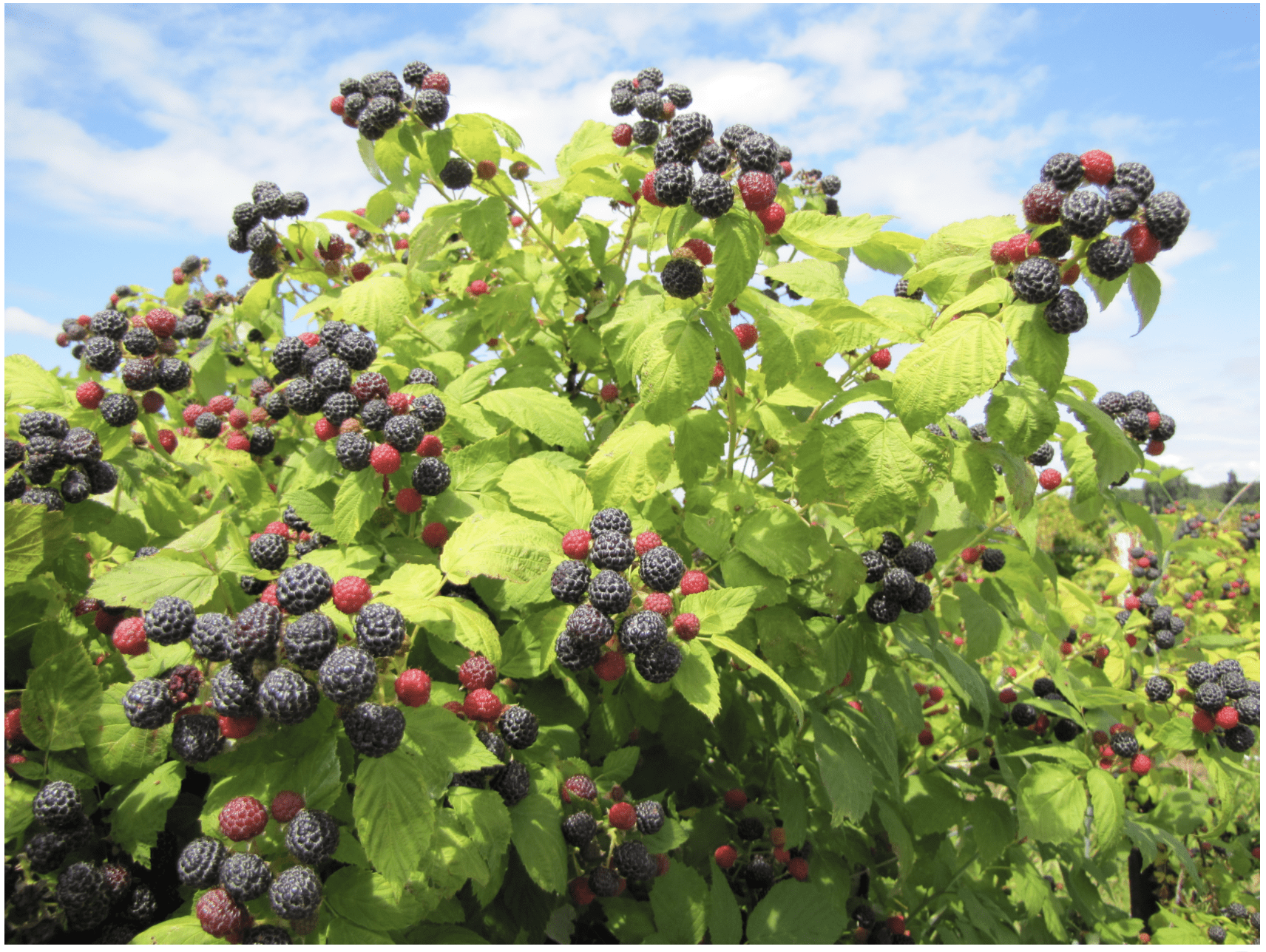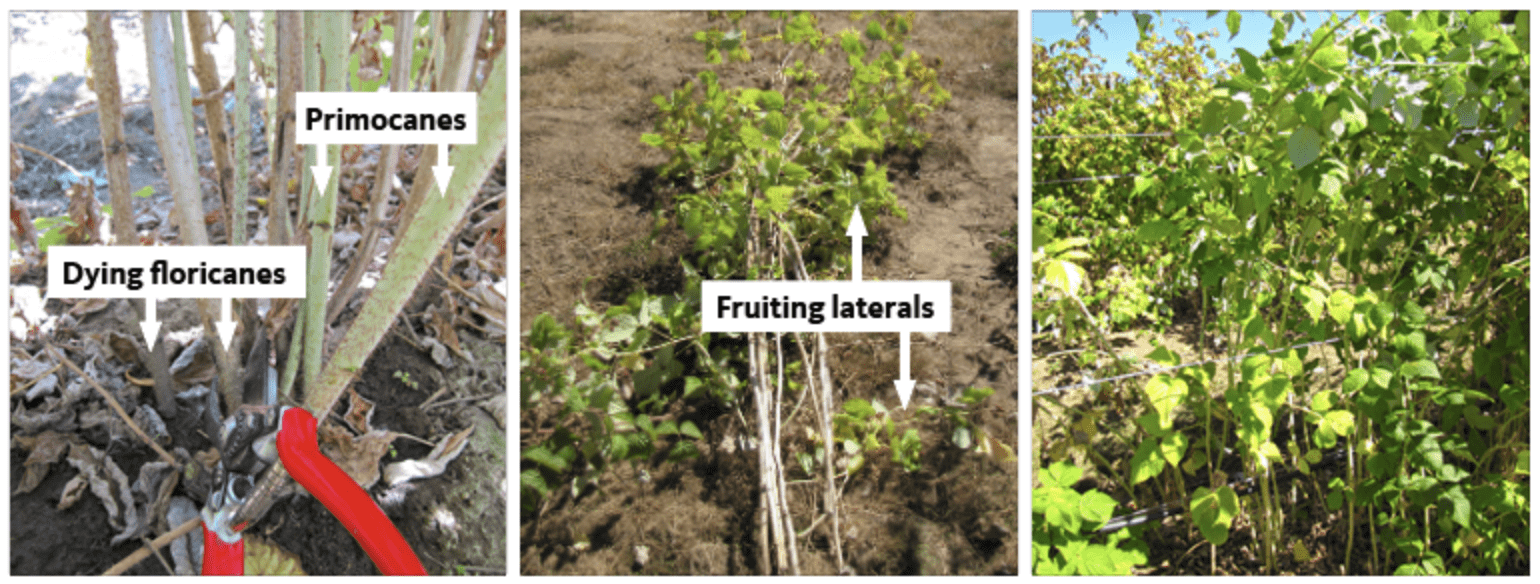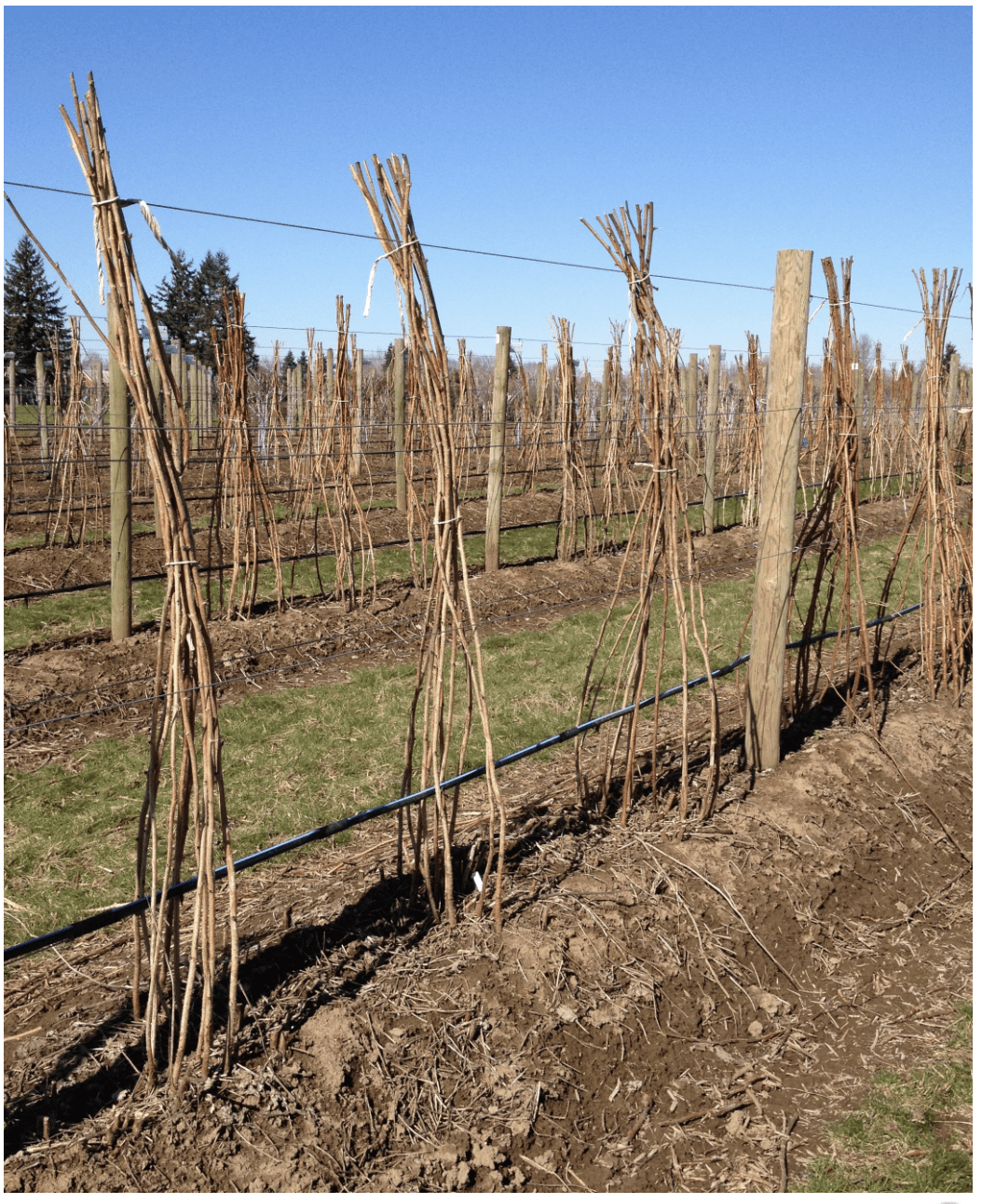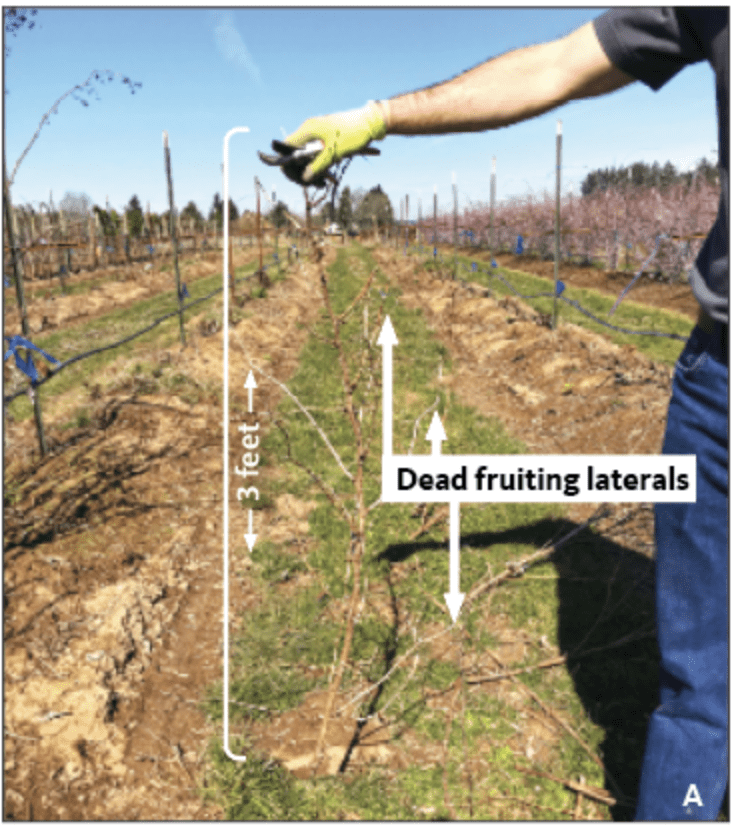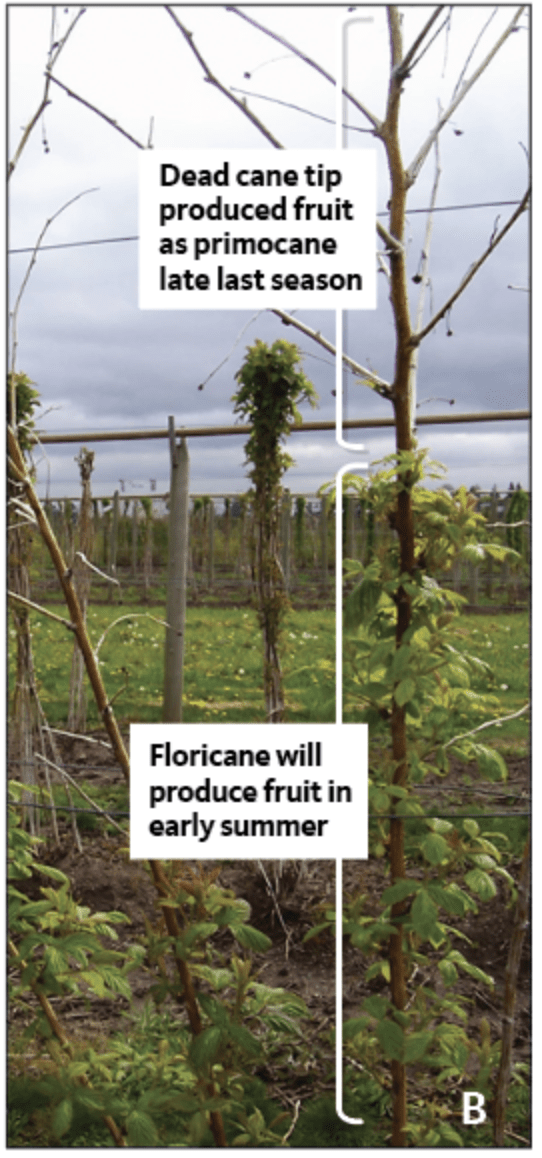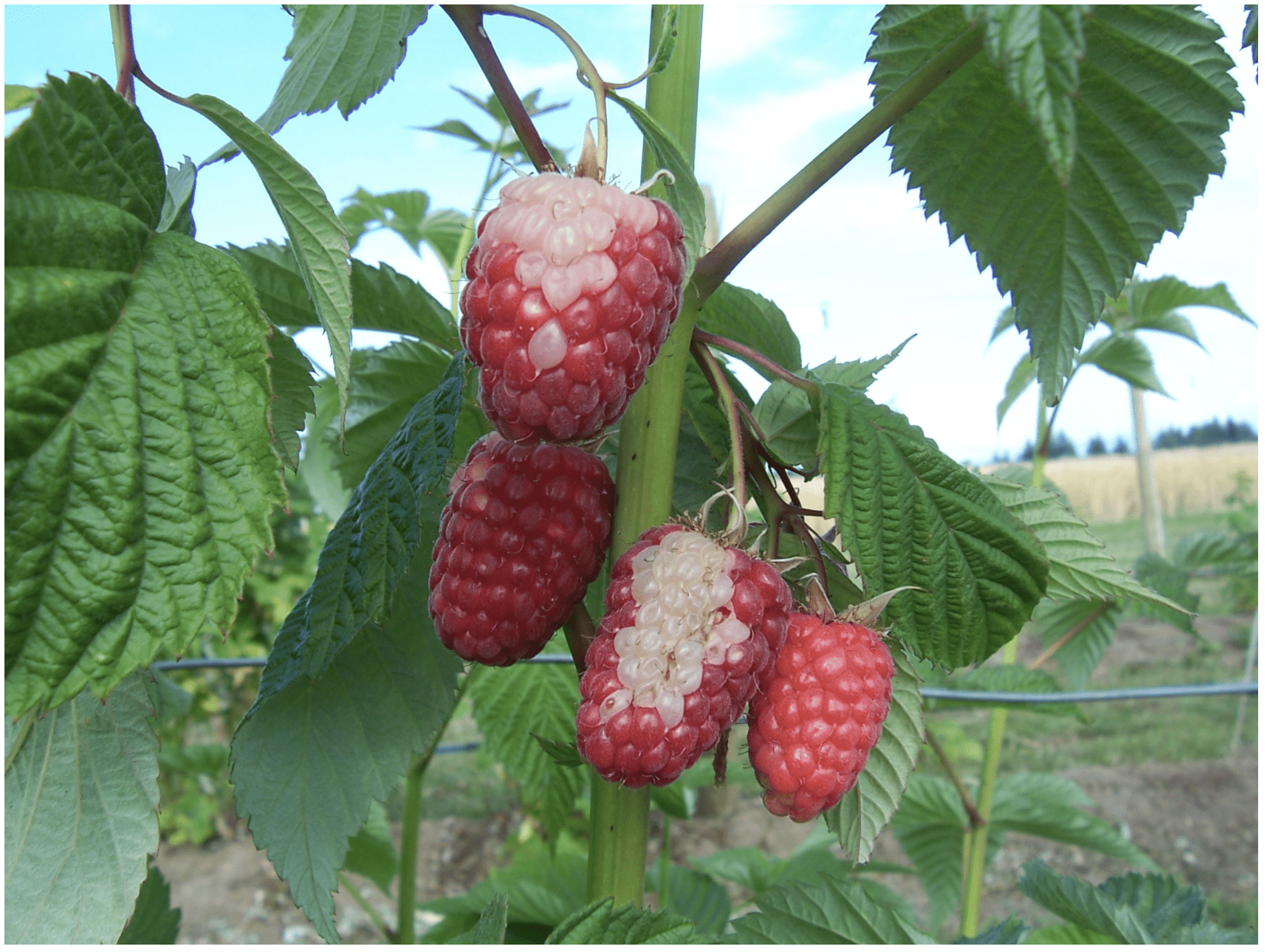Raspberries are one of the most delicious and delicate of berry crops. Their distinctive aroma and tart flavor make raspberries a favorite of home gardeners, and Oregon is a great place to grow them.
Raspberries are caneberries, a group which also includes blackberries and raspberry-blackberry hybrids. Caneberry plants produce fruit on hard, woody stems called canes.
Raspberries and blackberries can be distinguished by their fruit. Both produce a fruit made up of many individual sections, or drupelets (Figure 1A–C). Each drupelet encloses a seed. However, when raspberries are picked, the fruit comes off the receptacle — the white central core that stays on the plant — and the berry is hollow inside (Figure 1A–C). In blackberries, the receptacle stays attached to the fruit when you pick it — blackberries are not hollow.
The raspberries covered in this guide include red-, yellow-, black (also called blackcaps), and purple-fruiting cultivars, or cultivated varieties. Raspberry-blackberry hybrids such as ‘Boysen’ and ‘Logan’ (also known as “boysenberry” and “loganberry”) are trailing blackberries. See Growing Blackberries in Your Home Garden, EC 1303 for more information on blackberries.
Raspberries have a unique growth habit. The plants have a perennial root system and crown, or plant base. But the canes are biennial.
Red raspberry plants have a lifespan of 10 to 15 years, while black raspberry plants live for five to 10 years, depending on the presence of pests or adverse environmental conditions.
Raspberry types
Red- and yellow-fruited raspberry cultivars are either classified as summer-bearing (floricane-fruiting) or everbearing (primocane-fruiting). Each type is pruned and trained differently. Some yellow-fruited cultivars are simple mutations of a red-fruited cultivar. So, in some red cultivars, a yellow-fruited cane can grow in the raspberry patch.
The black raspberry cultivars commonly available all fruit on the floricanes, which means they are all summer-bearing. Blackcaps must be pruned and trained differently than summer-bearing red or yellow raspberries. Purple raspberries are hybrids between red and black raspberries but are pruned and trained most like blackcaps.
Fruiting habits
- Floricane-fruiting, or summer-bearing, raspberries produce vegetative canes, called primocanes, in the spring. Primocanes grow from buds on the crown and the roots (Figure 2). These primocanes grow throughout their first year and then go dormant in the fall. They overwinter and then produce flowers and fruit in their second year, at which point the canes are called floricanes. The floricanes die after fruiting. After the planting year, raspberry plants will have both types — primocanes and floricanes — at the same time (Figure 2).
- Primocane-fruiting (fall-fruiting, or everbearing) raspberries have a similar cane development and life cycle, except the tips of the primocanes flower and fruit in the late summer or fall of their first year (Figure 3). The portion of the primocane that fruited dies back in late autumn or winter. Then the remaining cane base will overwinter and will fruit as a floricane in its second year, but will have a much lower yield than the summer-bearing types. The floricanes die after fruiting. Everbearing raspberry plants can be pruned to produce one crop (primocane only) or two crops (early summer on floricanes and late summer and autumn on new primocanes).
Summer-bearing raspberries produce fruit in June and July, depending on the cultivar and region. The fruiting season of everbearing raspberries is in June and July on the floricanes and from early August until the first frost on the primocanes, depending on the cultivar and region.
All raspberry types produce primocanes from the crown and the base of old canes in the spring of each year (Figure 2). However, red and yellow raspberries also produce new primocanes from buds on the roots, and so these plants spread out from the place they are planted.
You can find several raspberry species in the wild in Oregon, all of which fruit on the floricanes:
- The salmonberry (Rubus spectabilis) has bright, dark brown, spiny canes that grow tall and arch over. Plants produce beautiful dark pink flowers (Figure 4A) and berries that change from yellow to orange (Figure 4B) and then to dark maroon red when fully ripe. Birds usually eat the fruit before they are fully ripe. You can find salmonberry in wetter, riparian areas in their broad native habitat (Figure 5).
- The thimbleberry (Rubus parviflorus) is native to broad areas of Oregon. Thimbleberries prefer forest understories or mottled shade at various elevations. Plants produce large, white flowers (Figure 6A) and delicious fruit (Figure 6B) that has a low pulp-to-seed ratio, making it seem a bit seedy or dry.
- The native red raspberry (Rubus strigosus) is more difficult to find, but is native to broad areas of Oregon, including at higher elevations. Deer and other animals typically eat these red raspberries before humans.
- The native black raspberry (Rubus leucodermis), in contrast, is easy to identify by its purple stems. Since it is such a prolific producer, you can often stop and enjoy the fruit while hiking (Figure 7).
Raspberry cultivars
It is important to choose a cultivar adapted to your region. Various types of raspberry differ in fruiting season and cultural requirements. Even cultivars within the same type differ in fruit quality, flavor, appearance, tolerance to pests, cold hardiness and plant longevity.
Winter cold-hardy cultivars adapted to the colder regions of Oregon (such as zones 5 to 7), may not grow normally in regions of the Willamette Valley (zone 8) where winters are warmer and plants receive less winter chill. Also, cultivars adapted to the Willamette Valley (zone 8, for example) may lack sufficient cold hardiness for central, eastern and southeastern Oregon (see “Common problems”). If you choose a summer-bearing cultivar or want to grow an everbearing cultivar for a double crop, then the cultivar must have sufficient cold hardiness on the overwintering cane to get a floricane crop; this overwintering primocane is exposed to cold temperatures and potentially drying winds. In contrast, an everbearing cultivar may be grown for a primocane crop only (single crop) in any production region, because no over-wintering cane is needed for this production method — only the crown overwinters in this production system. The total yield of an everbearing cultivar, grown in either system, is usually lower than that of a summer-bearing cultivar.
Table 1 lists cultivar suggestions noted for good flavor and pest resistance by type. A range in Cold Hardiness Zone may help you determine regional adaptation if you are growing in an area with a borderline USDA Cold Hardiness Zone. Be aware that cold hardiness zones vary within any one region. (For example, you may be in zone 5 because your home is at a higher elevation, while the majority of the region is in zone 6). See Raspberry Cultivars for the Pacific Northwest, PNW 655, or Selecting Berry Crop Varieties for Central Oregon, EC 1621.
You can find descriptions of newer cultivars online through various nurseries. Note susceptibility to disease, because this may limit planting life or production in your region. For example, cultivars susceptible to root rot are difficult to grow in most areas of the Willamette Valley.
Purple raspberries are not commonly grown in Oregon but may be a good addition to the home garden. They are excellent for processing into jams or pies. Choose a summer-bearing red raspberry cultivar if you want sufficient fruit during a more concentrated season for freezing or jam making. You may complement this with an everbearing cultivar for later season fresh fruit. It’s important to choose a cultivar adapted to your needs and site.
Whichever types and cultivars you choose, buy only certified, disease-free plants from a reputable nursery. It can be tempting to start your new planting by digging up “suckers” — primocanes that developed from buds on the roots — from your old patch or that of a neighbor. That route is easy and free. But it could also introduce pest-infested soil and virus-infected plants to your new planting. Also, many cultivars are patented and may only legally be propagated by licensed nurseries. Many of the cultivars in Table 1 (and more) are available through local retail and mail-order nurseries. Plants often sell out quickly, so order well in advance of spring planting.
Because raspberry cultivars do not need cross-pollination to produce fruit, you only need to choose one cultivar. However, growing more than one type or cultivar will allow you to compare them, have sufficient fruit for freezing or jam, and to have fresh fruit for an extended period.
Site selection
Raspberry plantings are productive for five to 15 years, depending on berry type, soil and pest pressure. Carefully select a site best for optimal planting life. Ideal environmental conditions for raspberries are full sun exposure and fertile, well-drained, sandy loam or clay loam soils with moderate water-holding capacity. While plants can tolerate partial shade, yield and fruit quality may be lower. Raspberry plants are sensitive to wet or heavy soils and are susceptible to root rot (see “Common problems”). Raised beds or mounded rows, if constructed correctly, can create enough height for adequate drainage, if necessary (Figure 8). If possible, avoid spots in your yard exposed to high winds, which may make ripe fruit fall during fruiting or increase the risk of winter cold injury to primocanes.
Raspberries, especially blackcaps, are also susceptible to verticillium wilt, a soil-dwelling fungal disease (see “Common problems”). Avoid planting in sites where other verticillium-susceptible crops (such as strawberries, kiwifruits, potatoes, tomatoes, peppers or eggplant) and numerous ornamental trees, especially maples, have been planted in the past five years. Being aware of alternate hosts and changing crops will also disrupt other soilborne pest and disease cycles.
Soil nutrient testing and modification
While you can grow raspberries in raised beds or containers with a good potting mix (see “Container plantings”), if you are going to plant raspberries in your garden soil, take a soil sample and have it tested prior to planting. Collect soil samples up to a year or more in advance. This will provide adequate time to amend the soil, if necessary. Take soil samples from the top 12 to 18 inches of soil where the roots will grow.
Raspberries require a soil pH of 5.6 to 6.5. If your soil test indicates that your soil pH is too low (too acidic) or too high (too basic) for raspberry production, you can amend the soil to improve the pH. A typical soil analysis will also include phosphorus (P), potassium (K), calcium (Ca), magnesium (Mg) and sodium (Na). In addition, test for organic matter and boron (B) — especially in the Willamette Valley, where B deficiency is common in raspberries. Nitrogen (N) levels in soil are not useful because N is not added prior to planting. Instead, supply N with fertilizer after planting. Table 2 shows recommended nutrient ranges in soil for raspberry.
For more information, see A Guide to Collecting Soil Samples for Farms and Gardens, Analytical Laboratories Serving Oregon, and Soil Test Interpretation Guide.
Soil that is not ideal for raspberries (soil with the wrong pH, poor drainage or the wrong soil type) can usually be improved. Gardeners can increase organic matter content, build raised beds, modify soil nutrient levels and modify soil pH to the ideal range with lime (to increase soil pH) or sulfur (to lower soil pH), if needed.
Soil pH
In the Willamette Valley and southwestern Oregon, a Shoemaker-McLean-Pratt, or SMP, buffer test is helpful for determining how much lime to apply if the soil pH is below the ideal range for raspberries. You can ask for this to be included on your soil nutrient analysis. In central, eastern and southeastern Oregon, soils tend to be neutral to more alkaline, so this additional buffer test is probably not necessary. Ideally, you would test the soil a year before you plant to give yourself enough time to modify the soil pH, if required.
If the soil pH is too high (above 6.5), acidify the soil with elemental sulfur. The application rate depends on soil type and the current pH of the soil. In sandy-type soils use approximately 1–3 pounds per 100 square feet; or in clayey-type soils use approximately 5–6 pounds per 100 square feet. For more information, see Acidifying Soil for Blueberries and Ornamental Plants in the Yard and Garden and Acidifying Soil in Landscapes and Gardens East of the Cascades. In general, if your soil pH is too low (below 5.6) for raspberry production, incorporate finely ground limestone at a rate of approximately 5 to 10 pounds per 100 square feet. You can also use high pH composts to add organic matter and increase soil pH. However, avoid composts with a high salt content (electrical conductivity, or EC), such as fresh animal manures.
Incorporate amendments into the soil about a year prior to planting, as it takes time for the soil pH to adjust after the addition of lime. See Applying Lime to Raise Soil pH for Crop Production (Western Oregon) and Eastern Oregon Liming Guide.
Drainage
Raspberries are sensitive to poor drainage. Because of their large root system, raspberries benefit when planted in well-drained soil that is at least 2 (and ideally 3) feet above the water table. Raspberry roots will suffocate in soils that are waterlogged for more than a few days in a row during the growing season, and the likelihood of root rot will increase. Gardeners in much of the state usually need raised beds either constructed of wood (Figure 8) or mounded soil (Figure 9) to ensure adequate drainage. Raised beds aren’t necessary in central or eastern Oregon, where the native sandy-type soils drain quickly. The minimum height for beds made of mounded soil is 1 to 1.5 feet high and for constructed raised beds is 2 to 3 feet deep (see “Container plantings”). Amend soil with any needed nutrients and organic matter. Organic matter aids in soil aeration, drainage, and water- and nutrient-holding capacity.
Organic matter
Raspberry plants often grow best with a soil organic matter content above 3 percent. You can increase soil organic matter content by incorporating fine, aged wood chips or sawdust, bark, well-composted manures or plant-based composts. Compost is the best option for amending native soil in central Oregon. It is important that whatever material you apply is free of pest insects and weed seeds. Apply organic matter 1 to 2 inches deep for each area. All of these organic materials differ in nutrient content, pH, salt content (EC), and carbon-to-nitrogen ratio (C:N), which affects the rate of decomposition. For more information on organic matter in crop production, see Improving Garden Soils with Organic Matter, EC 1561.
Incorporate the organic material into the soil by digging or tilling. Mixing the amendment in well ensures uniformity of soil properties. If you apply large amounts of fresh organic material with a high C:N, such as sawdust, you can aid decomposition by applying approximately 3 ounces of N per 100 square feet (see calculation below). In areas with little summer rain, irrigate the intended planting area to ensure amendments such as lime or sulfur and organic materials react well with the soil.
It is important to eliminate perennial weeds before planting because they are hard to control after planting. Don’t let annual or perennial weeds go to seed, and ensure that any amendments applied, such as composted yard debris or manures, are free of weed seeds.
Planting systems
Container plantings
When soil in the garden is not well suited for raspberry production (even after you make all possible amendments) or space in the yard is limited, you can grow raspberry plants in containers on a deck (Figure 10) or balcony or in constructed raised beds (Figure 8). Choose a site that has good sun exposure.
The best types of raspberries for container production are everbearing, pruned to produce two crops per season. However, summer-bearing red or yellow raspberries may also be grown in containers or raised beds using similar methods.
Since raspberry plants are relatively deep rooted, they require a pot or raised bed a minimum of 2 feet deep. A 20- to 30-gallon-sized container works well, but careful pruning is needed to ensure the plant doesn’t get too large for the container (see “Pruning red and yellow raspberries in raised beds and containers”). In a raised bed, use either the hedgerow or hill system for red raspberry, or establish as individual plants for black raspberry (see below). For more information on building raised beds, see Raised Bed Gardening, FS 270.
It is important that the potting mix and the container drain well. Make sure that water will drain into the soil below a constructed raised bed. A recommended soil mixture is one part perlite or pumice, one part finely ground bark, and two parts garden or potting soil; yard centers may sell a similar mix in bulk. If desired, mix slow-release, or sulfur-coated, fertilizer into the potting mix at a rate of 8 cups per cubic yard of potting mix.
Follow the planting, fertilizing and pruning recommendations described here. Summer-bearing red or yellow raspberries may be grown in a hedgerow or hill system. It is best to grow everbearing raspberries in a hedgerow. Black and purple raspberries are most easily grown as individual plants because they do not produce primocanes from buds on the roots; space plants 3 to 4 feet apart.
Hedgerow
Rows of raspberries should be spaced 8 to 10 feet apart and plants 2 feet (everbearing) to 2.5 feet (summer-bearing) apart. Keep any primocanes that emerge in the row area between plants. Maintain the row width to either 6 to 12 inches (summer-bearing) or 12 to 18 inches (everbearing), by removing any primocanes that emerge outside this row width by pruning, hoeing or rototilling (Figures 11A, 11B). If you allow wider hedgerows, management tasks such as weeding, pruning and harvest become more difficult and disease potential increases due to the dense canopy.
Hill system
The “hill” in a raspberry planting is the cluster of canes that develops around a plant; it does not refer to growing on mounds or raised beds. Plants remain more as individuals. The hill system may be used for summer-bearing red or yellow raspberry (Figures 12A, 12B), but these may also be grown in a hedgerow; home gardeners often choose a system they feel better suits the space, or a system that supports ease of pruning and training.
Rows should be 8 to 10 feet apart, and in-row plant spacing should be 2.5 feet. Individual hills should be restricted to a diameter of 1 to 1.5 feet by removing canes outside the hill, or between plants. During the growing season and in winter, if needed, remove all newly emerging primocanes that develop between plants or the hills and in the aisles or off the edge of the mounded raised bed (see “Pruning and training”).
Planting
Raspberry plants are sold as either bare-root plants (a short cane section with roots attached (Figure 13), or as potted plants. Plant raspberries as early as you can work the soil in spring. If they can’t be planted immediately, heel in bare-root plants by covering the roots with moist soil or sawdust. When planting, dig a shallow hole large enough to accommodate the roots. Spread out the roots and cover them with soil so that the highest point of attachment of roots to cane is 1 to 2 inches below the soil (Figure 14).
For potted plants, dig a hole large enough to accommodate the size of the root ball. Remove the pot and set the plant so that the pot’s container mix is level with the soil. Fill the planting hole with soil and firm the soil to remove air pockets. Water thoroughly and cut the canes of newly planted bare-root plants to 6 inches, if they are longer. Water young plants frequently to ensure plant roots do not dry out.
Whether you choose a hedgerow or a hill system for your red raspberry planting, they will look the same right after planting (Figure 15) and in the early spring as new primocanes grow (Figure 11B). By midsummer, remove excess primocanes outside the in-row area in both systems, and between plants in the hill system.
Mulching
Mulch can help control annual weeds, conserve soil moisture and, depending on the type of mulch, provide nutrients (Figure 16). Do not to bury the crown with organic mulch, as this can promote rot. Deep straw should not be used as mulch during the growing season because it can lead to increased rodent activity. In areas where soil can freeze and thaw during winter, apply mulch around the crown to help protect plants from cold injury.
Irrigation
Raspberries need adequate water to thrive, either from irrigation or rainfall. Fruit is made up of mostly water, so sufficient irrigation during fruit production is essential for the best yields and fruit quality. Newly set plants do not have well-developed root systems, so plants can be easily stressed. Irrigate several times a week or as needed so that the root zone and soil are thoroughly wetted but standing water does not accumulate.
Established raspberry plants typically require from 1 to 1.5 inches of water per week during the growing season, depending on plant vigor, stage of growth, soil type and weather. Monitor your irrigation carefully to ensure you are adequately watering. With each irrigation, wet the soil to a depth of 0.5 to 1 foot. The rooting area should be wet enough that the soil does not fully dry out between irrigation cycles. Sandy soils will require more frequent watering than heavier soils. You can dig down into the soil to check if the soil is wet — but not too wet — between irrigations.
Drip irrigation is ideal for raspberry production because it can reduce weed problems, conserve water and reduce diseases that are sometimes caused by wetting the canopy. Irrigate with a single line of drip irrigation per row with ½-gallon emitters spaced every 18 inches. You may also use a soaker hose, if you monitor soil moisture to ensure the proper amount of water is being applied.
Trellising
Raspberries require trellising to support the canes, protect them from wind damage and prevent fruit from touching the ground. The best trellis to use depends on the type of raspberry you grow.
Summer-bearing red or yellow raspberries
Summer-bearing raspberry plants need a permanent trellis for support. Set treated wooden or metal posts at each end of the row (3 to 4 inches in diameter and 6 feet above the ground) (Figure 17). Set metal T-style posts (Figure 18A) every 15 to 20 feet in the row. Training is easiest with two sets of two high-tensile wires (generally 12-gauge). Place one set near the top of the trellis (about 5.5 to 6 feet from the ground), attached directly to the posts, and one at about knee height, attached so you can remove them (for example, by using hooks, as shown in Figures 18A and 18B). This design will allow you to lift the lower wires out over the growing primocanes to pull them into the row and prevent damage during the growing season. Use a wire-tightener in each of the top wires. You can also use a single, high-tensile wire at the top of the post and install a cross arm on each post to support the lower wires. The cross arm should be about 12 to 18 inches long and nailed or bolted (Figure 19).
Everbearing raspberries
A simple “T”-trellis is most common for supporting primocane-fruiting red or yellow raspberries. The “T” trellis has a 1.5-foot-wide cross arm attached at about knee height. The T can be made using rebar with twine or wire strung down each side of the row to support the canes (Figure 20), or using metal posts and cross arms (Figure 19).
Black and purple raspberries
A simple “T”-trellis is most common for supporting black raspberries or blackcaps, with options similar to those for everbearing raspberries (Figures 19 and 20).
Nutrient management
Healthy raspberry plants with sufficient fertilizer nutrients have dark green leaves. Pale green or yellow leaves indicate a problem with nutrients, insects or disease. In particular, plants deficient in nitrogen will have older leaves that are paler green or yellow in comparison to younger leaves.
Your raspberry plants will need fertilizer in the planting and establishment years. There are many types of solid (granular) and liquid inorganic and organic fertilizers available. Most all-purpose garden fertilizers or organic products contain P (phosphate) and K (potash) as well as nitrogen (N), and some also contain Ca (feather meal, for example). Fertilizer sources range considerably in their nutrient content. For example, common inorganic fertilizers available for the home garden include 16–16–16 (16% each of N, phosphate, and potash), 20–20–20, and various slow-release sulfur-coated urea products. Organic sources include cattle (0.6–0.4–0.5) and horse (0.7–0.25–0.6) manure, yard-debris compost (1–0.2–0.6), cottonseed meal (6–7–2), feather meal (12–0–0), bone meal (2–15–0) and fish emulsion (3–1–1). Avoid using fresh manure products after planting; these may pose a food safety risk.
The main nutrient needed by raspberry plants after planting in all home garden soils is N. Depending on the type of fertilizer product, there are different application methods to ensure maximum availability of N to the plants. Inorganic granular fertilizers are often applied in equal portions, or splits, throughout the spring and summer to ensure maximum efficiency of plant uptake and minimize risk of salt stress. Granular organic fertilizers such as feather, soybean or cottonseed meals require longer periods of time for N to be available. Therefore, it’s best to apply granular organic fertilizers about a month before applying inorganic fertilizers. In general, liquid fertilizers are available relatively quickly to plants but may also move out of the root zone quickly. So, for liquid fertilizers, divide the total amount of N into smaller, more frequent applications, such as weekly, during a similar time period as for inorganic fertilizers (see below).
Fertilizer recommendations for N are given in weight of actual N per length of row for the year. How much fertilizer to apply depends on the percentage of N in the product. To calculate how much N to apply during the year, divide the amount of N you need by the percentage of N in the fertilizer. For example, if the recommendation is to apply 2 ounces of N and you are using 16–16–16 fertilizer (16% each of N, phosphate, and potash), the calculation would be 2 ounces ÷ 0.16 (decimal equivalent of 16%), or 12.5 ounces of the fertilizer product (Figure 21). In another example, if you wanted to use soybean meal (6–2–1), you would need about 33 ounces, or 2.1 pounds of product (2 ounces ÷ ٠.06).
New plantings
When fertilizing new plantings, plan to divide the total required N into three equal portions, the first starting two weeks after planting, the next one month later, and the last one a month after that (Table 3). When using organic fertilizer sources, apply the product relatively earlier, as described above. In sandy soils, apply inorganic fertilizers more frequently, dividing the total rate into more split applications, or use slow-release products, such as many organic sources of fertilizer (see above).
In the planting year, fertilize summer-bearing and everbearing raspberries with a total of 2 to 2.5 ounces N per 10 feet of row. Fertilize black or purple raspberries with a total of 0.5 ounces N per plant.
Adjust fertilizer amount or rate and timing, depending on how well plants are growing and your growing region. Broadcast granular fertilizer over the soil surface in the row, spreading it evenly in an area a little wider than the row width. Irrigate after you fertilize.
In raised beds, use a similar rate and timing of applications, but calculate the length of rows you are fertilizing and adjust the rate accordingly. In containers, calculate the amount of N to apply per plant; for example, there are five everbearing raspberry plants per 10 feet of row at the recommended spacing. Common slow-release garden fertilizers and soluble products (those added to water) have rates on their product labels that should work well for raspberry. If you choose to use fish fertilizer, be aware that it is salty and will injure plants unless diluted. Apply one part fish to 10 parts water.
Established plantings
For each year after the planting year, fertilize summer-bearing red or yellow raspberries with a total of 2 to 3 ounces N per 10 feet of row per year. Fertilize everbearing raspberries with 3 ounces N per 10 feet of row per year. Fertilize black or purple raspberries with 3 ounces of N per 10 feet of row.
Divide the fertilizer into two applications, applying the first in late March to early April (about the time when primocanes start to grow in the Willamette Valley). Adjust the timing for other growing regions. Make the other application about 1½ to 2 months later (late May to early June in our example). Apply fertilizer more frequently on sandy soil, dividing the total rate into more split applications; apply organic sources of fertilizer earlier, as described above. Everbearing raspberries may require an additional 1 ounce per 10 feet of row in 1½ to 2 months (mid- to late July, for example) to ensure there is adequate N available for the later fruiting period.
Broadcast granular fertilizer products over the soil surface in the row area (about 2 to 3 feet wide, centered on the row). Irrigate immediately after fertilization.
A well-managed plant should have healthy green leaves with good primocane growth (a good number per plant and a normal length for the cultivar and the growing region). Pale green or yellow primocane leaves, particularly toward the base of the cane, could indicate N deficiency. Primocanes that are too tall (10 feet or more), thin (less than 0.37 inch), or with long internodes (the distance between leaves) indicate an excess of N fertilizer.
Monitor soil pH every few years. Add lime in fall to increase soil pH in the Willamette Valley or southwestern Oregon. In central or eastern Oregon, add elemental sulfur to decrease soil pH and maintain it within the desired range for raspberries.
Harvest
Ripe raspberry fruit will separate easily from the receptacle. Harvest by hand with a gentle pull on ripe, fully colored fruit (Figures 1A and 1B), making sure not to squeeze the fruit, which reduces firmness and shelf life. In general, pick raspberries every three to four days, depending on the cultivar and the weather. Wash your hands and containers before picking. Pick regularly. This not only helps ensure you collect berries at their optimal ripeness, but also reduces insect pests and diseases that are more prevalent on overripe fruit (see “Common problems”). Check plants more frequently in warmer or wet weather. If an extended period of rain is forecast, pick berries that are fully colored but require more of a pull from the receptacle, as the rain may dilute the flavor and lead to fruit rot. Try to avoid picking when fruit is wet from dew, fog, or rain, and don’t wash raspberries before storing them. Wet fruit will decay faster. Place the fruit in shallow containers, so the weight of the fruit does not crush lower layers of berries (Figure 22). Refrigerate raspberries immediately for longer storage life and best quality.
Expected raspberry yields are 18 to 27 pounds per 10 feet of row of mature plants for summer-bearing red or yellow cultivars, depending on your region. (Where you live affects primocane growth, or vigor, and the risk of injury from winter cold.) Everbearing cultivars and black raspberries (Figure 23) will yield slightly less.
You’ll know it’s time to prepare a spot in your yard for a new planting when:
- Your plants lose vigor (when you see fewer or weaker new primocanes).
- Your fruit size is less than typical for the cultivar.
- Your plants have pest problems or diseases — like Raspberry bushy dwarf virus — that may not be controlled. See “Common problems.”
Purchase new, certified disease-free plants. Do not dig up and use primocanes from your existing planting to start a new one — these often contain viruses or will introduce diseases that will carry over to your new planting.
Pruning and training
For detailed explanations and video demonstrations of pruning and training methods from planting through maturity in summer-bearing, everbearing, and black raspberry, see the online course Pruning and Training Raspberries.
Summer-bearing red or yellow raspberries
Summer-bearing raspberries may be grown in a hedgerow or in the hill system. During the growing season, you may remove any primocanes that grow outside the in-row area by cutting them off at soil level with loppers or by tilling beside the raspberry row. Do not prune or tip primocanes that are in the desired row or plant area during the growing season. These canes need to grow straight without branches for optimal yield next year.
After fruit harvest, remove the dying floricanes (Figure 24A) by pruning them at the crown, near soil level (Figure 24B); this is called caning out. Cane out immediately after harvest, especially if there are cane diseases evident (see “Common problems”) or wait until canes are fully dead by pruning them in winter. Once the floricanes are removed (Figure 24C), tuck the remaining primocanes between the trellis wires (Figure 24D).
Pruning in winter involves caning out the dead floricanes (if that wasn’t done in summer), and pruning and training the primocanes. In the Willamette Valley and southwestern Oregon, prune anytime from December through February. However, in colder production regions such as central, eastern and southeastern Oregon, prune as late as possible in winter to reduce the risk of winter cold injury and to remove any cold-damaged tissue (see “Common problems”).
Cane out any dead floricanes present by cutting them at their base. Prune the remaining primocanes by removing weak, broken, diseased and insect-damaged canes. For hedgerow plantings, remove any primocanes that are outside the 6- to 12-inch-wide hedgerow by pruning or tilling. If you are growing plants in the hill system, leave all the healthy primocanes in the hill area and remove any that are growing between hills or plants and outside the row area. Tuck the primocanes between the lower movable wires (Figure 18A).
You may choose one of several primocane-training options in the hill system or hedgerow system. Primocanes may be topped to remove the very thin top growth (in all regions), or to the trellis height of about 6 to 6.5 feet if canes are longer. In the hill system, bundle the canes and tie the bundles to the top trellis wire (Figure 25). You may also tie canes individually to the trellis wires in the hill system or in the hedgerow, as this promotes good bud break and yield.
In plantings with more vigor and where primocanes are 7 to 10 feet tall, you can choose an arc-cane training system. Slightly tip the canes in late winter to remove very thin growth. Tie the cane bundle to the top wire and loop it down, tying the end to a lower training wire or along the top wire, depending on cane length (Figure 26). You may also tie canes individually to the trellis wires in the hill system or in the hedgerow, as this promotes better bud break and yield.
Everbearing raspberries
Grow everbearing red or yellow raspberries in a hedgerow. During the growing season, maintain the hedgerow to a width of 12 to 18 inches by tilling or hoeing any primocanes outside the row (Figure 27). Tuck the remaining primocanes between the trellis wires. Pruning in winter will depend on whether you are producing one or two crops per year.
Pruning everbearing raspberries for a double crop
If you are growing your everbearing raspberries for a double crop (floricane and primocane crop) per season, you will need to prune out the dying or dead floricanes after harvest (caning out). Cane out immediately after harvest only if there are cane diseases evident on the dying floricanes (see “Common problems”). Otherwise, leave caning out until winter so you minimize risk of damaging the primocanes, which may be flowering.
Pruning in winter involves caning out the dead floricanes (if that wasn’t done in summer) and pruning the primocanes. In the Willamette Valley or southwestern Oregon, prune any time from December through February. In colder production regions such as central, eastern and southeastern Oregon, prune as late as possible in winter to reduce the risk of winter cold injury and to remove any cold-damaged tissue (see “Common problems”).
Cane out any dead floricanes present by cutting them at their base; these canes will be shorter than the primocanes and will be dead from their tip to their base with dead fruiting laterals evident (Figure 28A). Prune the remaining primocanes by first removing any that are outside the 12- to 18-inch-wide hedgerow by cutting them at their base or tilling. Then cut out any weak, diseased or damaged primocanes that are within the hedgerow. Remove the dead tips of the remaining primocanes; these portions of the canes fruited last late summer to fall. If you don’t remove these dead tips, you will see the base of the cane produce fruiting laterals in the spring when it is a floricane (Figure 28B). In winter, cut off the dead primocane tip by pruning a couple of nodes below the dead portion (Figure 28C). Do this for all canes in the row (Figure 28D). These floricanes will produce the early summer crop. The late-summer-to-fall crop will be produced on the top portion of new primocanes that emerge.
Single crop
You can grow everbearing raspberries for only a primocane or late-season crop. This is common when you have the space to grow both summer-bearing and everbearing raspberries. You will get a higher yield on the floricanes of summer-bearing cultivars, which is an advantage if you like to make jam or freeze fruit.
If you are only growing everbearing raspberries for a single crop, cut all the canes to just above ground level in late winter (March) (Figure 29). Primocanes will emerge in the spring. Keep the hedgerow to a width of 12 to 18 inches (Figure 27) and tuck the primocanes between the trellis wires.
Pruning in raised beds and containers
If you are growing summer-bearing or everbearing raspberries in a constructed raised bed (Figure 8), prune your planting as described above.
For container plantings, in addition to pruning in winter, thin primocanes during the growing season (Figure 30). Wait until the earliest primocanes are about 2 feet tall. Thin the primocanes to keep from four to five (summer-bearing) or five to eight (everbearing) primocanes per 20- to 30-gallon container; remove primocanes that are thinner or shorter than average and those at the outside edge of the container (Figure 30).
Pruning black and purple raspberries
Black and purple raspberries will only produce fruit at the very top of a long cane under natural growing conditions. Pruning a primocane in summer during the growing season is called tipping. Tipping black and purple raspberry primocanes during the growing season increases yield four- to fivefold and makes the plants easier to manage.
Tip the primocanes in late spring or early summer by removing the top 3 to 6 inches (Figure 31A). Top them to a height of about 3 feet. You will need to go over the planting multiple times throughout early summer to catch all of the primocanes. The tipped primocanes will produce branches (Figure 31B).
Remove dying or dead floricanes any time from after fruit harvest through to late winter.
Pruning in winter involves caning out the dead floricanes (Figure 32) (if you didn’t remove them in summer), and pruning the primocanes. In the Willamette Valley or southwestern Oregon, prune any time from December through February. In colder production regions such as central, eastern, and southeastern Oregon, prune as late as possible in winter to reduce the risk of winter cold injury and to remove any cold-damaged tissue (see “Common problems”).
On the remaining primocanes, remove any damaged or diseased wood and use pruners to shorten the lateral branches on the primocanes to a length of 1.5 to 2.5 feet (Figure 33).
Common problems
Weather-related problems
Raspberry plants adapted to your region are cold hardy, but growing plant parts may still be susceptible to frost damage in late fall, or in late winter to early spring. Also, in some winters cold damage may occur when plants are not growing or are dormant.
Frost injury
Frost will injure open flowers at 30°F. While frost injury to flowers on the floricane is not common in the Willamette Valley, it may occur in other production regions. In central and eastern Oregon, frost can occur any time during the growing season. Frost may injure flowers and reduce yield. Frost in the fall will curtail fruiting on the primocane in everbearing cultivars in all production regions.
Winter cold injury
The temperature at which raspberry canes or buds are damaged depends on the time of the year, the weather preceding the freeze and the cultivar. Choosing cultivars that are adapted to your hardiness zone (see “Cultivars”) is important to minimize risk. Cold damage to canes is most common at the tip of the cane, the portion that grew and matured last, prior to winter (Figures 34A, 34B). Damage to raspberry buds may occur anywhere on the cane. On cold-damaged canes, fruiting laterals will either not grow (Figure 34A), or they will start to grow and will then collapse because the cane cannot support their further growth (Figure 34C). If buds on primocanes are killed by winter cold temperatures, bud break will be sporadic in the spring, leading to a reduced number of fruiting laterals on the floricane in spring and lower yield.
Poor pollination
While rain, heat or cool weather during bloom can reduce fruit set by limiting pollination directly or indirectly through reduced bee activity, this is not a common occurrence in raspberry. Raspberry flowers produce a lot of nectar and are very attractive to native and honey bees.
Sun damage to fruit
Intense heat — particularly when it occurs with low humidity — may lead to ultraviolet damage to red and yellow raspberry fruit. Sections of the berry exposed to the sun bleach white (Figure 35). Cultivars differ in sensitivity. You may use shade cloth to protect developing fruit.
Weeds and weed management
Weeds compete with raspberry plants for water and nutrients, so it is important to keep weeds out of the row. New primocanes can be easily broken, so take care to pull weeds by hand within the row. Hoe or cultivate to remove weeds and unneeded primocanes outside of the in-row area. Mulch, such as straw, sawdust or bark, may help control weeds (see “Mulching,” Figure 16).
Chemical weed control options suitable for raspberry plantings are limited in the home garden. Use extreme care when using glyphosate (Roundup®) to kill weeds anywhere near your planting; raspberry plants are very sensitive to this herbicide (Figure 36).
For detailed information on specific weeds and weed control, refer to the Pacific Northwest Weed Management Handbook.
Vertebrate pests
Birds, deer, squirrels and mice can be nuisance pests for raspberries. If you are not able to fence your entire property or garden area, netting can provide protection against many of these pests.
Insect pests
Spotted wing drosophila
The most important insect pest in raspberry production in western Oregon is the spotted wing drosophila, or SWD. This pest is much less prevalent or not found in central, eastern or southeastern Oregon. This vinegar fly looks a lot like the common fruit fly. The female lays eggs in developing fruit, generally after it first develops some color. The larvae feed inside the berry while the fruit is ripening without much evidence of the damage from the outside of the fruit. Populations of SWD build up during the season, so late-fruiting cultivars (such as the primocane crop on everbearers) are more prone to damage. You may use fine exclusion netting to prevent adults from reaching the berries. For more information on how to control and manage this insect, see “Resources.”
Raspberry crown borer
Raspberry crown borers can be found in the Willamette Valley. The adult is a clear-winged moth that resembles a wasp. Larvae bore into the canes and crown. The life cycle requires two years to complete. Symptoms of severe infestations include dead or dying plants (Figure 37). There is no control other than to remove infested plants and destroy or burn them, where permitted.
Rose stem girdler
This pest is a recent one to raspberry in the Willamette Valley. The adult is a small, metallic-colored beetle. Larvae burrow along the cane length, creating visible bumps. Canes can die above the feeding point (Figure 38A). When you identify this type of damage and see the larva (Figure 38B), cut below the infected cane section and destroy or burn (where permitted) these canes to kill the larvae. It’s important to do this before the adults emerge — generally in April or May in the Willamette Valley.
Other insects
Other insects that can be problematic in raspberries include raspberry beetle (raspberry fruit worm), stink bugs, root weevils, leafroller larvae, spider mites and aphids, depending on your production region. There are some viruses (not described below) that are vectored, or transmitted, by aphids. While native predators control many infestations, it may be helpful to control aphids, if needed. Check with your local OSU Extension office for control recommendations if insects become a problem or see the Pacific Northwest Insect Management Handbook.
Diseases
Raspberry bushy dwarf virus
Raspberry bushy dwarf virus, or RBDV, is a common, pollen-borne virus that causes crumbly fruit in red (Figure 39) and black raspberry (Figure 40). The virus is transmitted by pollinators such as the honey bee. A flower that becomes infected will not set the normal number of drupelets. This causes poor or lumpy fruit shape, leading to what is called crumbly fruit. While yellow leaf symptoms may occur in some everbearing cultivars (Figure 41), many cultivars only show the crumbly fruit symptom on infected plants. Plants have normal vigor, despite the name of the virus.
Once a plant is infected, it remains infected; bees visiting an infected plant in bloom will transmit the virus to other plants. There is no control for this virus. Once a planting becomes fully infected with RBDV, remove it and start a new planting in another location using new, disease-free plants. If you plant in the same spot, primocanes will emerge from any remaining infected root pieces in the soil; it will be impossible to distinguish between these infected primocanes and the primocanes from your new plants prior to bloom. The virus would then quickly be transmitted to your new planting. If you start in a new location you should still remove any primocanes that grow from your old patch prior to bloom. You can then use this old spot for any other crops (the virus will not be in the soil). Some cultivars are resistant to RBDV.
Root rot
Phytophthora root rot, a soilborne disease, is aggravated in wet, heavy soil. Symptoms include primocanes dying in midsummer (Figure 42) and fruiting laterals collapsing just prior to or during fruit harvest. Infected plants die over a period of time. Although most cultivars are susceptible to root rot, some are tolerant or even resistant. Check Raspberry Cultivars for the Pacific Northwest, PNW 655, for information on cultivar susceptibility to root rot. If you decide to replant in another area of your yard using newly purchased plants, check crops for tolerance or resistance to phytophthora root rot before planting in your old, infested spot.
Verticillium wilt
Black raspberries are especially susceptible to verticillium wilt, a soilborne fungus. Floricanes will collapse and die in late summer. Primocanes typically grow well during their growing season and then die the following year (Figure 43). There is no control for this fungal pest. Practice good crop rotation (see below). If you decide to replant using newly purchased plants, choose resistant plants when planting in your old, infested spot.
Botrytis fruit rot and cane disease
Raspberry fruit are susceptible to gray mold (Botrytis fruit rot) if there is overhead irrigation or rain during the fruiting period (Figure 44A). Remove and destroy diseased fruit from the planting as soon as it is visible. Some cultivars are also susceptible to cane botrytis (Figure 44B), which reduces yield of the cane next season. This is aggravated by dense canopies (such as in the case of wide hedgerows).
Yellow rust
Yellow rust occurs in western Oregon in spring when a significant rainy period follows a warmer period. Symptoms include yellow spots on the top of the leaves and then yellow fungal spots on the underside of leaves on the floricane (Figure 45). If left to advance, rust can progress to the berries, or the berries will die without leaves to support their development.
If the disease occurs, remove the infected floricanes and destroy or burn them (where permitted). In the fall, rake and burn the fallen leaves. Do not tie primocanes until after leaves fall. This breaks the disease cycle so that the rust spores do not spread to the primocanes that are growing.
A note on crop rotation
Crop rotation is an important tool for disrupting pest and disease cycles. For example, verticillium wilt has many other hosts, including potatoes, tomatoes, peppers, eggplant, kiwifruit and some ornamental plants, among others. Make sure raspberries do not follow or precede those crops.
Other diseases
Other diseases that can be problematic in raspberries include anthracnose cane disease in black raspberry, crown and cane gall, and spur blight. Incidence depends on your production region.
If disease becomes an issue with your raspberries, check with your local OSU Extension office for control recommendations. Also see the Pacific Northwest
Plant Disease Management Handbook.
Resources
Acidifying Soil for Blueberries and Ornamental Plants in the Yard and Garden, EC 1560
Acidifying Soil in Landscapes and Gardens East of the Cascades, EC 1585
Applying Lime to Raise Soil pH for Crop Production — Western Oregon, EM 9057
A Detailed Guide for Testing Fruit for the Presence of Spotted Wing Drosophila (SWD), EM 9096
Eastern Oregon Liming Guide, EM 9060
Growing Berries on the Oregon Coast: An Overview, EM 9177
Growing Berries on the Oregon Coast: Raspberries and Blackberries, EM 9180
A Guide to Collecting Soil Samples for Farms and Gardens, EC 628
Improving Garden Soils with Organic Matter, EC 1561
Laboratories Serving Oregon: Soil, Water, Plant Tissue, and Feed Analysis, EM 8677
Oregon State University Spotted Wing Drosophila information page
Pacific Northwest Insect Management Handbook, Pacific Northwest Plant Disease Management Handbook, and Pacific Northwest Weed Management Handbook, revised and reissued annually.
Pruning and Training Raspberries online course
Raised Bed Gardening, FS 270, https://catalog.extension.oregonstate.edu/fs270
Raspberry Cultivars for the Pacific Northwest, PNW 655
Selecting Berry Crop Varieties for Central Oregon, EC 1621
Soil Test Interpretation Guide, EM 8713
Trade-name products and services are mentioned as illustrations only. This does not mean that the Oregon State University Extension Service either endorses these products and services or intends to discriminate against products and services not mentioned.



